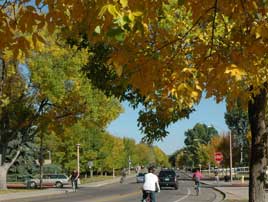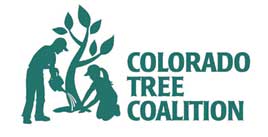Urban & Community Forestry
Urban and community forests are dynamic ecosystems that help clean air and water, and conserve energy. They also add form, structure and beauty to communities, reduce noise, provide places to recreate and add economic value to our communities.

Community Forestry Topics
- Emerald Ash Borer
- Seedling Tree Nursery – Find out the conservation seedling order options in your area
- Urban Wood Utilization
Communities too, have forests: trees appear along streets and greenways, in backyards and parks. These forests enhance the quality of human life by purifying air, modifying temperatures, reducing noise pollution, improving aesthetic appeal and raising real estate values.
The CSFS is available to help communities with their tree planting and tree care needs. Technical assistance includes help in devising plans to maintain and add to tree resources, and providing information and workshops on tree care. Caring for our trees not only protects our investment, but provides benefits for the future.
Assessing Urban & Community Forests
A tree inventory is not an end but rather a means to effective urban and community forest management. The Colorado State Forest Service can help your community decide which type of inventory is best suited for your needs, and provide options to meet those needs, as well as urban tree resource management planning. Contact a CSFS Field Office for more information.
Invasive Species Planning & Response
Strategies to cope with the introduction and spread of invasive species need to be identified and implemented prior to introduction and establishment to best alleviate negative consequences to our urban and community forests.
Invasive forest pests such as gypsy moth and Asian longhorned beetle (ALB) are most likely to be introduced into Colorado via firewood, logs or nursery stock. Existing diseases and pests such as the invasive insect emerald ash borer (EAB) that is now present in Colorado, thousand cankers disease (TCD) and mountain pine beetle (MPB) need to be deterred from spreading from one region of our state to another.
Caring for Storm-Damaged Trees
After a major storm, a community is instantly changed. Buildings may be damaged or destroyed, power lines down, and trees broken and torn. In the wake of this loss, neighborhoods and entire cities may experience a sense of devastation they have never known before.
Caring for Storm-Damaged Trees (5.3 MB PDF) is a quick guide that helps prepare for and manage your damaged trees.
Tree City USA/Tree Line USA/Tree Campus USA
Tree City USA

The Tree City USA® program, sponsored by the Arbor Day Foundation in cooperation with the USDA Forest Service and the National Association of State Foresters, provides direction, technical assistance, public attention, and national recognition for urban and community forestry programs in thousands of towns and cities that more than 135 million Americans call home.
The many benefits of being a Tree City include creating a framework for action, education, a positive public image and citizen pride.
Tree Line USA
Tree Line USA is a program of Arbor Day Foundation to encourage proper utility practices that safeguard trees. Trees need not be brutalized or destroyed to allow the safe and dependable delivery of utility services, the Tree Line USA program encourages utilities to become involved with this program.
Tree Campus USA
The Tree Campus USA program recognizes college and university campuses that effectively manage their campus trees, develop connectivity with the community beyond campus borders to foster healthy, urban forests and strive to engage their student population utilizing service learning opportunities centered on campus, and community, forestry efforts.
If your community, utility or college campus is interested in any of these programs, contact a CSFS Field Office or get more information from the Arbor Day Foundation.
Arbor Day
A day to celebrate the planting of trees was the idea of J. Sterling Morton, who promoted tree planting while employed for the Nebraska Territory. The very first Arbor Day was celebrated in Nebraska in 1872 and was inaugurated by planting over a million trees in just one day. According to Colorado Revised Statutes (C.R.S. 24-11-104): The third Friday in April each year shall be set apart and known as “Arbor Day,” to be observed by the people of this state in the planting of forest trees for the benefit and adornment of public and private grounds, places, and ways in such other efforts and undertakings as shall in harmony with the general character of the day established.
To learn much more about the Tree Planters’ Holiday and how you can incorporate an Arbor Day celebration in your community visit the Arbor Day Foundation website.
Colorado Tree Coalition
The mission of the Colorado Tree Coalition® (CTC) is to lead statewide efforts to preserve, renew and enhance community forests in Colorado.
CTC is a volunteer, non-profit 501(c)(3) organization administered by the Colorado State Forest Service.
The organization works closely with partners such as the U.S. Forest Service, Xcel Energy, and several corporate and private sponsors to provide programs and services to communities across Colorado.
Programs administered by CTC include the Champion Tree, Tree Risk Assessment and Fifth Grade Arbor Day Poster Contest programs. Additionally, the Trees Across Colorado program provides low cost trees to Colorado communities, and the ReForest Colorado program helps communities recover from natural disasters.
CTC is a membership driven organization, and it encourages communities across Colorado to become a member to enhance their chances of obtaining tree planting and maintenance grants.
For more information, visit the CTC website at www.coloradotrees.org.

